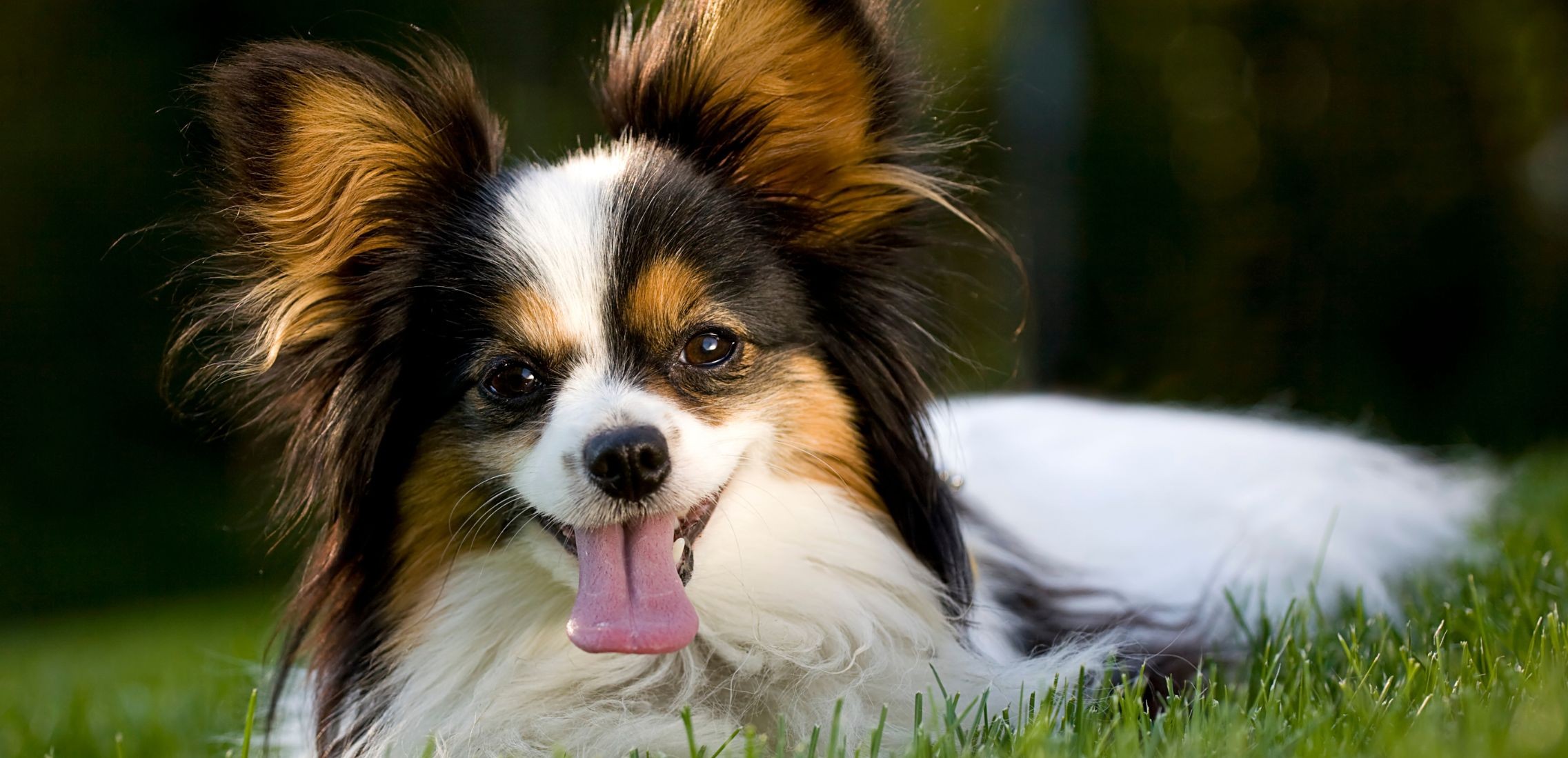Your Cart is Empty
Get Up To 35% OFF & Free Delivery
Get Up To 35% OFF & Free Delivery
Get Up To 35% OFF & Free Delivery

Originally favored by French royalty for their distinctive appearance, Papillons have transformed from being doted on by aristocratic courts to becoming beloved canine companions in households worldwide. With a charming and affectionate nature, they’ve been capturing hearts for centuries.
If you’re one of those who got charmed by these little beauties, you’re in for a treat in this blog post! Or if you’re considering inviting a Papillon dog into your home, here’s everything you need to know.
In this dog profile, we are going to dive into what you need to know about the Papillon breed: their traits, temperament, health considerations, and a guide to getting your perfect Papillon puppy.

Lifespan
14 - 16 years

Size
Small / Toy Breed

Weight
5 - 10 lbs

Height
8 - 11 inches

Colors
Any color, but the most common colors are white with black, tan, or brown markings

Size of home
Any size; convenient to smaller living spaces like apartments or condos

Exercise
They require at least 30 - 60 minutes of moderate exercise every day, including walks and prolonged play periods

Grooming
Monthly professional grooming and bath, and weekly brushing











Papillon dogs are one of the oldest breeds of toy spaniels. They are widely known for their affectionate and sociable nature, making them generally good with children. These dogs are the happiest when they are at the center of attraction or involved in family activities. Their small size and sociable nature make them well-suited for multi-pet households, given that proper introductions are made at an early stage.
One of the unique characteristics of Papillon is their ears resembling the open wings of a butterfly–hence their name. They also have high intelligence and agility, making them excellent in obedience and agility training or competitions. Despite their small frame, they possess a high level of energy so regular exercise and mental stimulation is a must for them.
Fun facts:
The term “Papillon” means “butterfly” in French, which perfectly describes their signature ear shape.
Papillons have always historically been connected with nobility, as they were originally bred to become noble companions.
One of the most famous historical figures who adored this breed is Marie Antoinette, the Queen of France.
They are often featured in paintings alongside their noble owners.


From historical records and artworks, it was believed that Papillons are the modern representation of the Continental Toy-Spaniel, which had drooping ears and feathery coats. However, in the 1500s the Italian painter Titian depicted small Spaniels in his works, who were rather similar to the Spaniels of the day. This has led to the speculation that Titian’s Spaniels were the original ancestors of the Papillon.
Spaniels were originally bred to be hunting dogs, but as their popularity grew, smaller versions of this breed were developed for companionship. In the early 16th century, different Spaniel breeds often appeared in portraits accompanying their noble owners.
(These little charmers might even be the original influencers, posing for portraits and capturing everyone’s heart way before social media became a thing!)
After the French Revolution, they became more common in every household. Then, a variety with erect ears caught the public’s attention. Aside from their ears, the breed’s color drastically changed over time. The small Spaniels, who were originally solid-colored, were now predominantly white with colored patches. Soon after, the term “Papillon”, which means “butterfly” in French, was adopted for the breed.
The Papillon’s defining features, along with their small size and friendly nature, made them highly sought after as companion dogs. They were particularly favored at the French court for their beauty and grace; two notable royals who adored this dog breed are Louis XIV and Marie Antoinette. With their elegant appearance and loyal nature, the Papillons made a long history intertwined with nobility and art. Renowned painters during that time, such as Rubens, Van Dyke, and Rembrandt have featured the Papillon dog in their artworks. In the late 1800s, the breed was introduced to America and quickly became as popular as they were in Europe.


In the early 1900s, the Papillon started gaining recognition as a separate breed. Meanwhile, the drooped-ear variety became known as “Phalenes”, which means “moth”. Then, in 1915, the American Kennel Club (AKC) registered its first Papillon. While AKC considers the Papillon and Phalene as a single breed, some parts of Europe still consider them as separate ones.
Today, Papillons are not only loved for their historical significance, but also for their intelligence, agility, and affectionate nature. They remain one of the most popular breeds across the globe, continuously capturing hearts with their charm and elegance.
The Papillon is a petite breed with an elegant, yet playful appearance. Here are the key breed standards of the Papillon’s appearance as reported by the Papillon Club of America:
Size and Proportion: the Papillon is one of the smallest dog breeds. They usually stand between 8 to 11 inches, with any height exceeding 11 inches considered a fault, and a height over 12 inches a disqualification. A Papillon dog’s body should be slightly longer than its height, maintaining a delicate frame that is in harmony with its all-over size. They don’t look chunky or heavy.
Head and Expression: The Papillon has a small, refined head with a slightly round skull. They have dark, round, alert eyes with black rims that add to their expressive look.


Ears: the Papillon breed are instantly recognizable by their big, fringed ears, resembling the open wings of a butterfly, hence their name. These butterfly-like ears are large with rounded tips.
Coat and Color: Another distinguishing feature of the Papillon is its coat. The coat is shorter on the head, muzzle, front legs, and from hind feet to hocks, but longer and feathered on the ears, forelegs, and hind legs. They are predominantly white with colored patches, the most common tints are black, crimson, and sable.
Tail: The Papillon's tail is set high and carried arched over the body, adorned with a long, flowing plume of hair. It should maintain this arched position whether in motion or at rest, contributing to its butterfly-like look.
Overall, Papillons might have a small stature, but they move with a lively and confident stride. Their light frame does not hinder their spirited and energetic personality. This vibrant demeanor combined with their elegant appearance has captivated dog enthusiasts for centuries.
Papillons generally tend to be happy dogs. They are friendly with children and love to play with them, but you mustn't leave them alone without supervision, as accidents might happen if they’re handled roughly by children.
This dog breed is generally affectionate and loves being near their owners. They enjoy spending time as a lapdog, curling up with you on the couch, or following you from room to room. These dogs also love being the center of the attraction and forming strong bonds with their family.
(That said, if you’re someone who’s mostly away from home and cannot take them with you to work, then Papillon dogs are not for you.)


Papillon dogs are known for being outgoing, as they easily get along well with other dogs or animals. They are the perfect choice if you want to make an addition to your multi-pet household. And while they respond well to socialization, like other dogs, Papillons still need careful introductions to foster positive relationships. Given their small size, it is best to introduce them to pets of similar stature, as larger animals might intimidate them without proper introduction.
Papillons also thrive in an interactive environment. Whether indoors or outdoors, these small balls of furs love to move around. Their intellect and athletic nature make them a good choice for agility or rally competitions. They can be easily trained to learn basic commands and tricks. These active puppies enjoy various activities, including fetch games and agility drills, demonstrating their cheerful personality.
Before you begin training or disciplining your Papillon, here are some things you might need to consider:
1. Patience: Papillons are highly energetic dogs, so you will need extra patience when training them. Due to their lively nature, training sessions might get challenging, but with determination and consistency, they can learn effectively.
2. Health Check: Ensure that your Papillion is in good shape before starting the training. Your goal is to improve your dog’s behavior and skills, not to inadvertently harm their wellbeing.
3. Positive Attitude: Your Papillon can pick up your mood, so maintaining a positive attitude is crucial. While it is good to take each training session seriously, it is even better if both you and your dog enjoy the time together and bond through the experience.


4. Training Space and Tools: Have a designated training space, free from distractions. A calm environment will help your Papillon focus better. Treats, leashes, clickers, and toys can also be helpful in every training session.
5. Planned Sessions: Have a list of commands and exercises planned out for each session. It will help you to ensure a smooth training process and make it easier for your Papillon to retain what they are learning. Additionally, training can sometimes be exhausting, not just for you but also for your dog. Therefore, it is important to schedule breaks between each session to let your pet relax.
In general, house training small dogs can take longer than larger breeds, but Papillons make the process faster. With their quick comprehension abilities, early teaching builds positive habits and behaviors from the start.
As we mentioned before, the Papillon breed is known for its intelligence. Teaching them obedience might seem like a walk in the park due to their quick learning ability. However it’s important to remember that puppies, whatever the breed, tend to have a short attention span.
The technique to effectively train a Papillon is to keep the sessions short but engaging. Also, use simple one-word commands combined with gestures like “sit”, “stay”, and “come” for them to easily understand what you behavior you want them to demonstrate.


Papillons respond well to positive reinforcement training methods, so make sure to always praise them when they exhibit good behavior, as this practice will encourage them to repeat the behavior in the future. If your Papillon shows any undesired behavior, you can use redirecting techniques to correct these behaviors. Never shout, yell or physically punish a Papillon for not following a training command.
Due to their high agility level, Papillons are known to excel in agility training and it is common to see the Papillon participating in agility competitions. This activity involves navigating through different obstacles, providing both physical and mental stimulation for them, in a competitive environment. So if this is something that interests you, a Papillon could be the ideal breed for you.
Despite being a breed with long, silky hair, Papillons are surprisingly low-maintenance when it comes to grooming. Here’s a guide to grooming your Papillon dog:
Brushing: Papillons don’t shed too much but it is still advised to brush their coat once or twice a week using a soft-bristled brush. Brushing will help to prevent mats from forming.
Bathing: When it comes to bathing, you can do it once a month or as often as needed using a mild dog shampoo. Always rinse thoroughly to ensure no shampoo residue remains. Clean their ears with a veterinarian-approved ear cleaner and check them for any signs of infection.
Coat Maintenance: Papillons’ hair doesn’t grow continuously, so visiting a dog grooming salon once a month is generally fine. Still, it is important to ensure that the hair around their paw pads and sanitary areas doesn’t grow too long.


It’s important to note that the Papillon breed can be known to be a picky eater. This can make mealtimes a bit challenging, so here are some dietary recommendations you can try:
Food Type: Choose high-quality food formulated especially for small breeds. You can try to experiment with different types of foods, such as wet food, dry kibble, or a combination of both, to find what your Papillon prefers.
Portion Sizes: As they might eat in small portions, the important thing is to ensure that their food is nutrient-dense. A general guideline is to feed them small, frequent meals throughout the day rather than large portions at once.
Papillons are lively, energetic dogs, so it is also important to have a daily exercise routine for them. Here are some exercise recommendations:
Daily walks: Adult Papillons usually need an hour of physical activity per day. This activity includes at least one or two moderate walks per day (approx 20 minutes) and a prolonged play period. Using a harness is advisable to prevent neck strain, as Papillons have strong predator instincts and may chase smaller animals like birds or squirrels. It is also important to keep in mind that Papillons are a breed with a single-layer coat, so they may need protection when doing outdoor activities during cold weather.


Playtime: Fetching games, tug-of-war, and agility are all activities that can keep Papillon dogs physically and mentally stimulated.
Training: Consider adding obedience training and mental challenges to your Papillon’s daily routine. Teach them new tricks or let them play with toys that dispense treats as these activities will keep their mind sharp.
Papillons might enjoy these fun-filled activities but you must remember that as a toy breed, they are more fragile than bigger dog breeds. With their small stature and lighter bone structure, Papillons are more prone to injuries if mishandled or if an accident occurs. Gentle handling and supervision around children or larger animals can help prevent injuries from occurring.
Papillon dogs are generally a healthy dog breed. Nevertheless, there are still some health conditions that need to be aware of. If you’re planning to get a Papillon, here are the common health issues you need to take note of:
Also known as “slipped stifles”, this is a common hereditary health issue with small breed dogs. A luxating patella arises when one or both kneecaps pop in and out of place. These can sometimes be painful, as the kneecap might get stuck on one side of the knee. Even if the patella does not get stuck, the friction from patellar luxation can develop into arthritis, a degenerative joint disease.


If your Papillon has a luxating patella, veterinarians normally recommend lifetime joint supplements as well as weight management. Depending on the severity of the condition, some Papillons undergo surgery to prevent further health issues.
Toy or small-breed puppies might also be born with a soft spot on their skull. Much like the human baby’s, it normally closes after a few weeks but in some instances, the soft spot does not fully close. While it does not typically affect the dog, it does increase the risk of obtaining brain injury or even death upon impact to that spot.
Some dogs are born with a narrower trachea compared to the normal. While on other dogs, the cartilage rings that support the trachea weaken causing it to collapse or narrow. Small breed dogs, like Papillons, are more prone to this condition.
A collapsed trachea causes coughing and difficulty in breathing, especially during hot weather and after exercise. Frequent coughing and breathing difficulties may lead to more serious health issues, especially asphyxiation.


This is a common condition in any size and breed of dog. Visible signs are bad breath, redness on the gums, and tartar buildup. This health problem can be at least prevented or controlled with regular teeth brushing.
Ultimately, preventive measures and early detection play an important role in managing your Papillon’s health. A regular visit to your veterinarian is essential for comprehensive health assessments. Vaccinations can likewise help protect against common infectious diseases.
Be observant and look out for subtle changes in their appetite, energy level, or behavior as this can indicate any developing health issues. Maintaining a healthy weight and providing your Papillon with regular exercise can contribute to their overall well-being.
Whether you are buying or adopting a rescued Papillon puppy, one thing to always keep in mind is: doing your research first. When buying from a breeder, ensure that they are reputable and transparent about the puppy’s health and lineage. It is also best to see the puppy’s parents to get a sense of its personality and health. A responsible breeder will be open to answering any questions you have about the breed and the specific puppy.
If you choose to adopt instead, seek guidance from rescue groups and organizations. Shelter environments can be stressful to any dog, causing them to behave differently than they would at home.


Additionally, rescue organizations usually offer valuable resources and support systems to help new owners and their chosen dogs transition smoothly. Adopting is not only cost-effective but also saves a dog’s life and provides a loving home for a pet in need.
Overall, always consider the personality when choosing any dog and whether your lifestyle will support their needs. Making an informed decision will help you ensure a harmonious relationship with your new Papillon puppy.
The cost of a Papillon puppy varies according to area and popularity. The normal range of a Papillon can be around $900 to $3,200, but prices for Papillon dogs are heavily influenced by lineage and coat color. Dogs that originate from champion lines and with the rarest coat colors will cost several hundred dollars more than the baselines listed above.
Take note that this price range is just the initial cost of your puppy. Owning a Papillon, and any other dogs, incurs regular costs like veterinarian care, insurance, grooming, food, and care supplies.


These amounts can also vary depending on the cost of vet care in your area, and the pet brands you decide to shop with. Training classes, especially for socialization and obedience, might be another potential expense.
Sure, Papillons may be small and cute, but they definitely live up to their "luxurious" or "elegant" reputation. So if you're considering getting a Papillon, make sure you are financially prepared for both the initial costs and ongoing expenses.
Papillons are undoubtedly a charming addition to consider in your family. Whether you choose to buy a Papillon puppy from a breeder or adopt it through a rescue organization, personality is the main consideration you need to take to ensure that both you and the puppy are compatible with each other.
The key takeaways about this breed are as follows:
Papillons are sociable and thrive on companionship.
Their agility and intelligence make them well-suited for activities like obedience training and agility competitions.
They react well to positive reinforcement training methods, as they love praise and encouragement.
This breed may be prone to health issues such as luxating patella, open fontanelle, collapsed trachea, and dental problems.
The cost of a Papillon varies depending on your region and their coat color.
If you’ve enjoyed learning about Papillons, why not explore our other fascinating dog breed profiles? Who knows, you might find your perfect match if Papillons aren't quite what you're looking for. Happy exploring!
Follow Us On
Check Out Our Most Popular Content